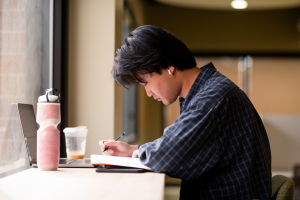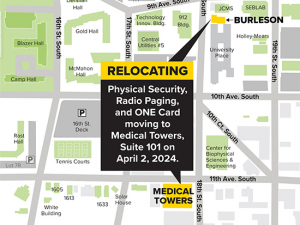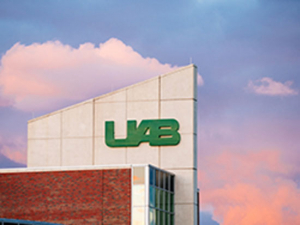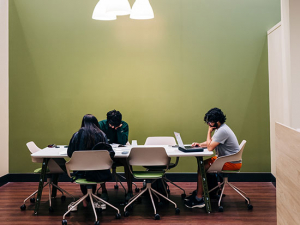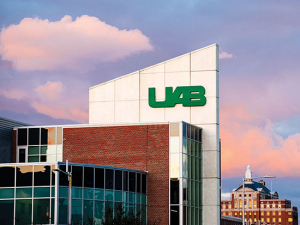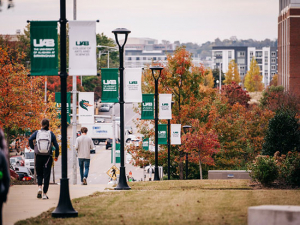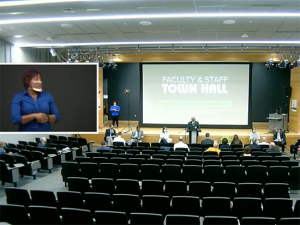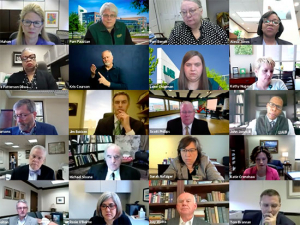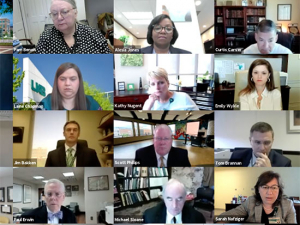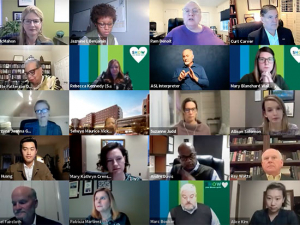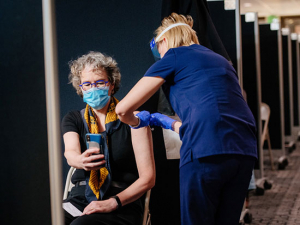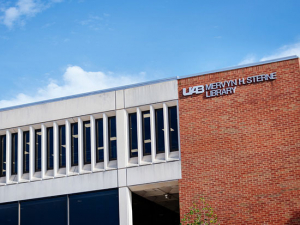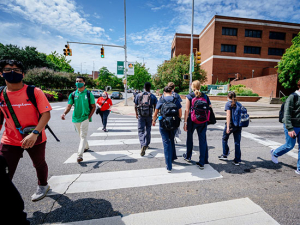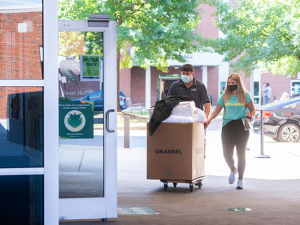UAB’s campus entry plan for the fall semester, set to begin Aug. 24, is the most comprehensive in the nation, President Ray Watts told employees during a town hall Aug. 14. Watts and other UAB leaders shared encouraging early data and explained the innovative digital tools being used.
“Data will drive our decisions, and we have among the best monitoring programs in the world,” Watts said, as he detailed the combination of entry testing — required for all 22,000-plus UAB students and optional for faculty and staff — and ongoing sentinel testing and symptom assessment through UAB Healthcheck that will be continually monitored by the university’s Incident Command Committee throughout the semester.
Scroll down to read the complete summary or use the links below to jump to specific topics
Data on UAB’s experience with testing so far
Sentinel testing and entry testing
403(b) match and hiring suspension
COVID-19 Awareness Training changes
Justice issues and diversity training
Data on UAB’s experience with testing so far
Thousands of employees are already working onsite, Watts noted. “We have brought back our entire clinical enterprise… [and] most of our research enterprise,” he said. And all testing to date has shown positive test rates of less than 1%.
Every employee has a role
Every employee has a role to play in making sure that the continued campus entry proceeds as smoothly as possible, Watts added. “We’ve got all these great plans and all this science and medicine and public health [expertise] behind us, but human behavior is going to be critical to our success,” he said. “That’s why we’re going to have zero tolerance for non-compliance with our safety measures: wearing a mask at all times, physical distancing, good hygiene and not gathering in groups…. It’s our responsibility to take care and protect all of those around us. And if we do that, we can stop this virus. We know that these measures will stop the spread and that it is low in our population. We want to keep it that way.”
[back to topic list]
What will classes look like?
“We’re now 10 days away from most of our students coming back for the beginning of the fall semester,” said Provost Pam Benoit. “So I want to spend just a little bit of time talking about what that will look like for students — some of you may not only be employees, but may also be students as well.”
Delivery formats
Classes will be offered in four different formats, Benoit said:
- In-person
- Hybrid
- Remote
- Online
The details of each format are explained on the uab.edu/uabunited site and in this breakdown from the Center for Teaching and Learning.
Hybrid and remote courses will be made possible through cameras, microphones and speakers installed in more than 160 classrooms all over campus. Learn more and see motion-tracking cameras in action in this UAB Reporter article.
“Classroom schedules are up now, and it is possible to look at each one of the classes that a student has elected to see what delivery format that class will be offered in,” Benoit said.
[back to topic list]
Classroom distancing
“The other thing we've done is that we've measured all of the classrooms and I want to do a big shoutout to [Chief Facilities Officer] Greg Parsons and the Facilities team,” Benoit said. “They helped us figure out how many students could be accommodated in every one of the classrooms we are teaching classes in this fall. And we have taken chairs out or wrapped chairs and desks, so that people will maintain their social distancing.”
Click through a slideshow of these redesigned classrooms spaces in this UAB Reporter article.
A number of questions submitted by employees asked about procedures to ensure ventilation and airflow in UAB classrooms and other facilities. “All of our spaces have fresh outside air,” Parsons said. “Many of our buildings have 100% outside air. Some have 10- to 20% outside air, which results in air changes of four to six air changes in a space per hour. We've maximized the outside air where we can. We've also installed the highest quality filtration available for the units on campus.”
| This article summarizes comments made and questions answered during the Aug. 14 town hall. An upcoming article will provide answers to questions that could not be addressed live due to time constraints. |
The reduced occupancy in classrooms and other spaces plays a major role in the safety measures, Parsons added. “The typical occupancy in a classroom [for the fall semester will be] about one-third of its design occupancy,” he said. “In essence that provides you three times as much air per-person as the space was designed for…. We have done the maximum that we can to provide the most outside air and the best filtration.” Masks also are essential, Parsons said. “Think of your mask as your personal air filter that is with you at all times. It helps protect you and protect others.”
[back to topic list]
Events and dining on campus
John Jones III, Ph.D., vice president for Student Affairs, and Lori McMahon, Ph.D., dean of the Graduate School and chair of the Entry Implementation Committee, answered questions about rules regarding gatherings on campus this fall, as well as dining access for students.
“We are in the process of communicating with our regular student organizations regarding programming here on campus,” Jones said. “There are certain criteria they have to meet,” including wearing masks, staying at least six feet apart and staying under a set capacity for indoor and outdoor events. “Currently, we’re looking at, in indoor space, no more than 10 individuals and, in outdoor space, no more than 20 individuals,” Jones said.
“We are asking that all seminars and other [academic events] be held online or continue to be virtual, as has been done since towards the end of spring and all through the summer,” McMahon said.
Most regular student dining options will be available, including restaurants in the Hill Center and in the Commons on the Green, Jones said, although there will be no inside dining. “It will be primarily ordering online or grab-and-go,” he said. The World of Wings and Sterne Library Starbucks locations are closed for renovations and the dining options at the Collat School of Business also are closed.
“We are asking that students do not eat in the classroom during lectures,” McMahon said. “Students will have space to listen to their taped lectures, study and eat lunch in Bartow Arena and also in the School of Education. And then of course outside space is great for students, staff and faculty to have lunch.”
[back to topic list]
Mask distribution
Masks are “required for faculty, staff and students,” Benoit said. UAB will be providing students and employees with two UAB-branded cloth masks. Faculty will receive two face shields for teaching, in addition to the cloth masks.
Employees can pick up their masks in a drive-thru distribution Express Lot 4, from 9 a.m.-noon Aug. 21-22. See the masks, find details and a map to Express Lot 4 and learn about alternate distribution locations in this UAB Reporter article.
| This information is accurate as of publication. For the latest information on testing procedures and protocols, visit the uab.edu/uabunited site. |
“You will need your ONE Card in order to claim your mask, and you can only pick up your masks,” Benoit said. “You are not required to wear this [UAB-branded] mask. We happen to think this mask is pretty cool. But if you want to wear a different mask, that’s fine, too.”
[back to topic list]
UAB Hospital and the July surge in Alabama
“Our clinical enterprise has been back in full force.” said Selwyn Vickers, M.D., senior vice president and dean of the School of Medicine. In April and May there was a period “where we were in decreased density in the hospital where we were looking for a surge… and then gradually ramped back up,” he said. “And as most of you are aware, we've also then had to do that in the face of some increased [COVID-19-positive] numbers within our state, particularly around Memorial Day and July 4…. It looks like we're getting to the end of that July 4 rise, as well as benefitting from a statewide mask order.”
Across the country, “those states that don't use that mask order or have been late or been incomplete in its compliance, [COVID-19] wreaks havoc on the community,” Vickers said. “We do think that seeing the number of cases go down gradually over the last few days is a sign that the mask order is working and that… we're getting further away from that July 4 intervening event, where people were out… and engaged.”
[back to topic list]
‘Extremely comprehensive’ plan
Vickers then shared details of UAB’s “extremely comprehensive” entry planning, developed at the direction of President Watts, the University of Alabama System and Chancellor Finis St. John. The plan has five parts, Vickers said:
1. Education and communication. The plan is built on regular communication and “we’re not taking anything for granted,” Vickers said. “As Dr. Watts said, we are going to be driven by data, and we’ll share that [data] as things evolve.”
2. Masks, distancing and other behaviors. Wearing masks and other face coverings, physical distancing, hygiene and other behaviors “will allow for successful continuation of our plan [and] also limit transmission of the virus,” Vickers said. “That’s a critical part that we can’t underestimate.”
3. UAB Healthcheck. “We’ve had the unique opportunity — for our campus first, our system next and now all the colleges in the state — to add the ability to have a regular COVID-19 screen,” Vickers said. Healthcheck is an artificial intelligence-driven tool that helps all members of the campus community know when to stay home if they are experiencing symptoms and can quickly connect them with Employee Health or Student Health for testing or follow-up care.
Many employees asked about how often they needed to fill out the Healthcheck. This will become a daily requirement Aug. 24, Watts said. “When Healthcheck was set up initially it was an every-three-day reminder, because that was felt to be often enough to be able to really track the virus,” Watts said. “But as we've worked through it operationally, and as… some of our clinical students and others have gone to a daily use,” the benefits of a requirement to fill out Healthcheck daily have become clear, he said. “It is very easy to use. It's simply answering a question: Do you feel well today or do you not feel well today? If you feel well today… you get that green Passport on your smartphone and that means you're fine to go wherever you need to be that day. If you're not well, it'll be red and you can't go; it will give you instructions about what to do. There's a whole algorithm within that that will give you step-by-step instructions of what to do.”
Using Healthcheck daily allows it to become a part of an employee’s regular routine, Watts said. “Every three days is an odd time and if for some reason you didn't get notified… you might not even think about it. But if you do this every day before you walk out of the house or soon as you pick your smartphone up in the morning… you are ready for the day and you won't forget.”
The daily approach also will allow the Incident Command Committee to “follow and track those data on [the committee’s] dashboard, so we will know where we need to intervene or where there might be an issue,” Watts said.
4. Contact-notification app. “But we didn’t stop there [with Healthcheck],” Vickers said. UAB has led the country, and is “really one of the few leaders in the world to develop a technology-driven contact-notification app,” he said. With traditional contact tracing (which is still part of the process at UAB), someone who is contacted after they have had a positive COVID-19 test can only remember who they have interacted with over the prior days about 50% of the time, Vickers said. “This app takes care of that.” Anyone with an Android or iPhone smartphone with Bluetooth enabled can download the app and, if they test positive, can send an anonymous alert to anyone they have been in close contact with during the previous 14 days. “Close contact” is defined as being closer than six feet from a person for 15 minutes or more.
Questions submitted online:
Employees had questions about the privacy of the app and if their family members could use the tool.
“Privacy permeates every aspect of the app,” said UAB Chief Information Officer Curt Carver, Ph.D. “We've built it in from the ground up. The app does not track your location. It does not track your identity, does not access your contact list. Instead, it's generating a random identifier every 10 to 20 minutes… and then uses a verification system with the Alabama Department of Public Health to ensure that if you come into contact — contact being defined as [being] within six feet [of another app user] for 15 minutes during a 24-hour period — then you're going to… receive a notification to the app.”
Data “while it's inside the app is encrypted,” Carver said. “The data when it moves across any network is encrypted. So there's a lot of privacy and security built into the app to ensure that your privacy is protected and your data is confidential.”
Everyone in the state of Alabama can use the app, Carver said. It was officially opened to the public and posted in the Apple and Google app stores Aug. 17.
A major marketing campaign began Aug. 17 “to get everybody in the state to use it,” said Rosie O’Beirne, interim vice president for marketing at UAB. “So please help us out and share and encourage others to use it.”
5. Entry and sentinel testing. UAB is leading the GuideSafe Entry Testing initiative, which will test more than 200,000 college students in Alabama. The School of Medicine’s pathology department has been able to make tremendous leaps forward in testing, to the point where it can now process anywhere from 5,000 to 8,000 tests per day.
Sentinel testing, which will be available to all students, faculty and staff at UAB, involves testing a random sample of the onsite population each week. Results from sentinel testing allow leaders to keep track of the level of asymptomatic infection in a population. In the sentinel testing from the first week in August, the positivity rate was 0.02%, Vickers said, which is “very low.”
In testing of students who returned to campus early, such as medical students, “there have been a few who have been infected,” Vickers said. But “that has not come from a transmission at work — it has come from their community.”
[back to topic list]
Questions submitted online:
Can a person request an antibody test [at UAB] and what kinds of tests are we conducting?
“We do have antibody testing available,” said Sarah Nafziger, M.D., medical director for UAB Employee Health. “But quite frankly, it has limited utility at this point because the science is unclear about what we do with the result from an antibody test whether it be positive or negative.” At this time, “Employee Health does not routinely offer antibody testing for our employees because we frankly just don't really know what the results mean as far as work restrictions or your future risk of catching COVID-19.”
For diagnostic tests, “our testing platform that we utilize for employees who are symptomatic is a PCR-based testing platform,” Nafziger said. “It is the same one that we use for our patients in the hospital or our community members at our community test sites.”
Is it possible for employees who are eligible for sentinel testing, but who haven't been invited to do so, to volunteer to be tested?
“If you're on campus, we're trying to honor the randomization process,” Vickers said. “And it's probably easiest to wait to you get your randomization to get tested.”
When an employee is tested, how long does it take to receive results?
“When you report your symptoms using Healthcheck, we have a call center that will call you to schedule your testing, typically within 24 hours,” Nafziger said. “Then the day that you get tested we get the results back, usually in the late evening or overnight of that same day. You get a call the next day with test results.”
For employees who need testing, “we prefer strongly for employees… to go through us, because we can get the results back so much quicker than we've seen with some of our other sites off campus,” Nafziger said.
[back to topic list]
Incident Command Committee
The Incident Command Committee, led by Katie Crenshaw, UAB’s chief risk and compliance officer, is constantly monitoring data from sentinel and entry testing, along with many other metrics, Vickers said. (Read more about the Incident Command Committee in this UAB Reporter article.)
“We’re not going through this blindly, by any means,” Vickers said. “We’re going with our eyes wide open… Our principle is not that we could ever remove all risk, but to do all we can to mitigate risk. And I think we’re doing that.”
Several questions submitted for the town hall asked about the metrics guiding UAB’s decision-making around entry or specific milestones that would lead to closure. “There are a number of factors that we are monitoring to evaluate how effective our UAB community can be in the campus entry plan that Dr. Vickers and Dr. Watts outlined,” Crenshaw said. “Of course, we're watching community data and offering that to senior leadership, so that our experts in UAB medicine and public health can help interpret that and look at modes of instruction and phases of return. But more than that, the Incident Command Committee is evaluating how effective we are with this multi-pronged approach. So we're looking at things like training completion and daily Healthcheck completion. We’re also looking at incidents where there are reports of failure to comply or failure to follow masking guidelines or distancing guidelines so that we can intervene quickly and make sure that everyone understands the expectations.”
In a student town hall on Wednesday, UAB student government leaders “talked a lot about personal responsibility and our responsibility as members of this community to hold each other accountable,” Crenshaw said. “What this is going to require is forming new daily habits and really a culture change for how we engage with each other on campus. If we implement these strategies consistently, we can be effective in mitigating the spread of the virus here at UAB.”
Employees also submitted questions on the timing of UAB entry phases. “When the entry plan was launched on the website there were target dates associated, but it was made clear in the context that it would be public health indicators that would be driving those phases of return,” Crenshaw said. “We still are in a modified business operation, which means we are still limiting capacity here on campus and [using] all of the strategies that you've heard today.”
Crenshaw encouraged employees to visit the uab.edu/uabunited website “and keep in touch with their unit leaders to understand what their operational plans are,” she said. “If employees have concerns about what this will look like for them on a daily basis, [they should] be in touch with supervisors and unit leaders to understand what their specific operational plan includes.”
[back to topic list]
Benefits
Alesia Jones, chief human resources officer, answered a number of recurring questions for Human Resources.
403b match and hiring suspension
“We communicated a timeline in May” explaining when we hope to be able to restore the 403(b) retirement plan and remove the hiring suspension, Jones said. Both will be considered at the end of the current fiscal year, Sept. 30.
“There's continued monitoring of the financial situation to make certain that we will be able to continue on that timeline as expected,” Jones said. “Right now I don't know the answer to that, but know that it's still being closely monitored and with hopes that will be able to continue on the earlier communicated timeline.”
Although the hiring suspension is still in place, “recruitment continues for select jobs,” Jones said. “UAB is still hiring and we're still hiring for those jobs that are critically needed. So anyone who's been displaced, looking for a new opportunity or even members in our community who want to join the UAB family, we encourage you to apply for those jobs that are open on the UAB career site.”
Merit pool
There were also questions about the possibility of a merit raise pool being available for the 2021 fiscal year. “Fiscal year 2021 begins on Oct. 1,” Jones said. “We have announced that there will not be a merit pool for fiscal year 2021 but there has not been any determination for fiscal year 2022. That decision is usually made sometime in the June/July-ish timeframe. So we would expect that that would happen again next year.”
Early retirement plan
“At this point, there are no plans for an early retirement plan,” Jones said. “That's something that we keep out there [as a possibility] and if we need to continue to look into that, know that we will. But right now, there are no plans to offer that.”
Remote work
Jones said that she had heard from several employees about the effectiveness of remote work for their positions. “But on the other hand, I've heard that there have been some challenges that have existed with remote work,” she said. “HR is working to put together resources that can help ease those challenges and provide guidance for leaders.” This guidance should be ready soon, Jones said.
COVID-19 awareness training changes
“Since we developed the COVID-19 awareness training in May, there have been continued improvements in UAB safety strategies and you heard about some of those even today on this call,” Jones said. “Last week we rolled out an updated training. Our team also developed a short video that highlights what those changes have been for those of you who took the training after it was first implemented in May.” This information will be launched the week of Aug. 17, Jones said.
Jones concluded by encouraging employees to take advantage of the resources available at UAB. “During this challenging time when all of us… are doing so much to take care of others, I want to remind you not to lose sight of taking care of yourselves,” she said. “I want to encourage you to look at the virtual wellness tips about exercise and healthy eating” on the Human Resources site, “and also learn as much as you can about the many resources that are available through our Employee Assistance and Counseling Center,” she said.
[back to topic list]
Will UAB have another round of furloughs?
“No, we are not planning on any additional furloughs,” Watts said. In fact, he said, “we are excited about the future.”
UAB’s clinical enterprise “has returned to its financial health,” Watts explained. The research enterprise at the moment is about 7% ahead of this past year’s figures, which were the highest in university history, Watts said. Enrollment was a source of concern in the early days of the pandemic, but in the recently concluded summer term UAB had higher numbers for enrollment and credit hour production than in summer 2019. “Coming into the fall semester, we are anticipating perhaps being down 2%, something like that,” Watts said, “but that's a lot less and earlier when we thought it could be 5% or 6% or 7%. And the closer we get and the more everybody sees the comprehensive nature of this plan, the more people are making a decision, yes, I'm going to enroll this fall.” State appropriations to higher education were stable, Watts added. Overall, “our budgets are going to be slightly up — 2% or 3% perhaps.” There are increased costs in dealing with COVID-19 that will have an impact, Watts said, “but the bottom line is, we're anticipating financial stability going forward.”
If something unexpected occurred, “then obviously we’ve got contingency plans for every scenario,” Watts said. “But we intend to be successful. And if all of our employees and students work together, we can do this safely.”
[back to topic list]
New childcare resources
Emily Wykle, project director in the Office of the President, provided details on results from a recent childcare survey at UAB and the university’s response. Wykle began by thanking “those of you at home or at work who are parents and have navigated this summer with all of the demands of both childcare and busy job schedules — I know that that has been really hard,” she said.
“We recognize that moving into fall changes in some of the school district reopening plans will cause even more uncertainty for a lot of UAB families,” Wykle said. “And so I'm really proud that UAB leadership has had a finger on the pulse of this issue since this past spring,” when UAB “convened a childcare task force that has been surfacing some of the challenges and issues that UAB’s working parents are facing.”
School reopening plans clearly presented a potential problem for UAB employees, Wykle said. “To better understand the scale of the problem and how this issue of childcare and K-12 district changes was impacting the workforce, we conducted a survey at the end of [July] to understand the scale of the problem.”
The survey had thousands of responses, Wykle said. “This is obviously something that has been top of mind for a lot of employees.” Results included:
- “Nearly 1,000 of our survey respondents said that due to changes in school district reopening plans, they did not have a childcare or education plan in place to allow them to do their jobs this fall,” Wykle said.
- The three biggest school districts with employee children enrolled were Jefferson County Schools, Hoover City Schools and Birmingham City Schools. “All three have moved to either all-virtual or a hybrid model,” Wykle said.
- For university employees, the biggest challenge “was around access to drop-in care — the opportunity to have somewhere safe to leave your kid for a couple hours while you do concentrated work on campus, whether that's teaching a class or working in the lab,” Wykle said.
- Another challenge was for “employees who are working full-time on campus and now don't have access to full-time care,” Wykle said. “And so while that was a more significant issue on the medical side, that is something we're seeing on campus as well.”
The focus of the survey was on the school year and how K-12 school reopening plans were impacting families, “but I do want to acknowledge that we know that the pandemic has also caused shortages in childcare slots for people who have children that are birth to five and we're working on providing resources around that as well,” she said.
UAB is responding with three options for employees, Wykle said (learn more about each of these options in this UAB Reporter article):
- Drop-in study program for the children of UAB employees. “The goal here is that UAB will provide a safe and supervised environment where your child can come for a couple hours a week to complete their remote learning assignments, and this is going to be held at the Hilton at UAB,” Wykle said. “It'll be staffed by UAB students and other certified and trained individuals. And children will have to bring their masks. They'll have to bring a device. And we will be following all the social distancing and other safety requirements that that the rest of the campus follows.”
- The program will be held Aug. 31-Oct. 30 “and at that point we'll reassess whether there's a continued need,” Wykle said.
- Employees interested in the program can pre-register now.
- The drop-in program is open for children in grades K-8.
- Full-time care at the McWane Center. UAB has partnered with the McWane Center, which “will be offering full-time care slots in an educational environment for employees who are onsite workers and deemed essential,” Wykle said. “UAB campus has 27 of those slots that we will be able to offer to our employees and there are subsidies available.
- The program includes an application process that closes Wednesday, Aug. 19. “The criteria for that application really focus on financial need, of the family and the essential nature of the employees job role,” Wykle said.
- The McWane program is open for children in grades K-6.
- Listing of available care facilities. “Obviously UAB employees are not the only ones who are facing challenges here,” Wykle said. “We are maintaining a list of programs that have availability,” from birth to high school-age, she said, “and we will continue to keep that posted throughout the fall.” School of Medicine Dean Selwyn Vickers, M.D., “is also working with a group of civic leaders who are trying to come up with a comprehensive community response” to the issue, Wykle noted.
[back to topic list]
Justice issues and diversity training
A question submitted online asked if UAB leadership was following the concerns about justice at UAB voice on social media. “We sent communications to the site administrators, providing them with some information in terms of ways that students or anyone who has a concern could reach out to us anonymously,” said UAB Chief Diversity Officer Paulette Patterson Dilworth, Ph.D. “Also, the Office of Compliance has a hotline that similar complaints can be reported and I would encourage anyone who has a concern to use that.”
Question submitted online:
Is there implicit bias or diversity training offered to UAB staff?
“Yes, we have five modules that are offered to staff,” Dilworth said. “You can actually visit our website at uab.edu/dei … where you can see the schedule of courses as well as all of the modules that are offered.”
[back to topic list]
Benoit concluded by thanking UAB employees for their hard work. “We are so proud of all the efforts that you've done to this point and as Emily mentioned earlier, we know it hasn't been easy with childcare issues,” she said. “The thing that I am most impressed about is that at UAB, everybody is really working very hard to have a successful semester and I will tell you if I was going to be any place during this kind of a situation, it would be at UAB. I'm so proud to be here with everybody working so hard and being able to use the incredible expertise that we have on this campus to develop this kind of a sophisticated plan.”
Dr. Watts agreed. “There's no place I'd rather be than UAB and I'm proud of all of our faculty and staff and our students, proud of our resilience, proud of how we serve our community, even in the midst of the worst pandemic we've ever seen in our lifetime,” he said. “We hope you can recognize how serious we are about being as thoughtful going forward as possible.”
